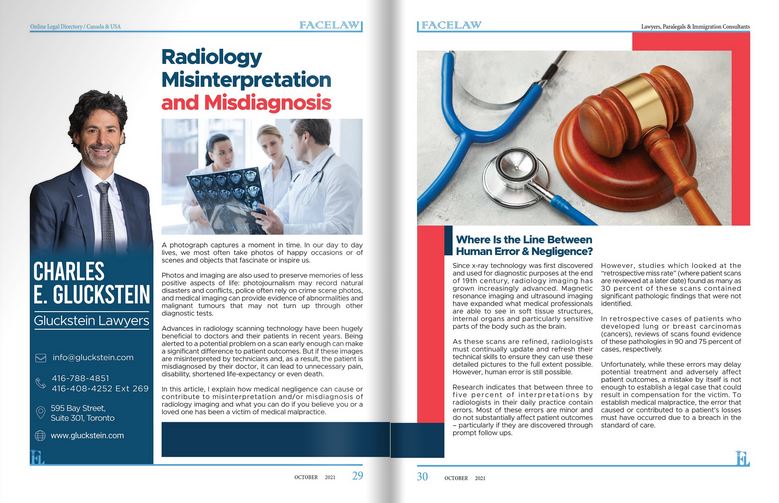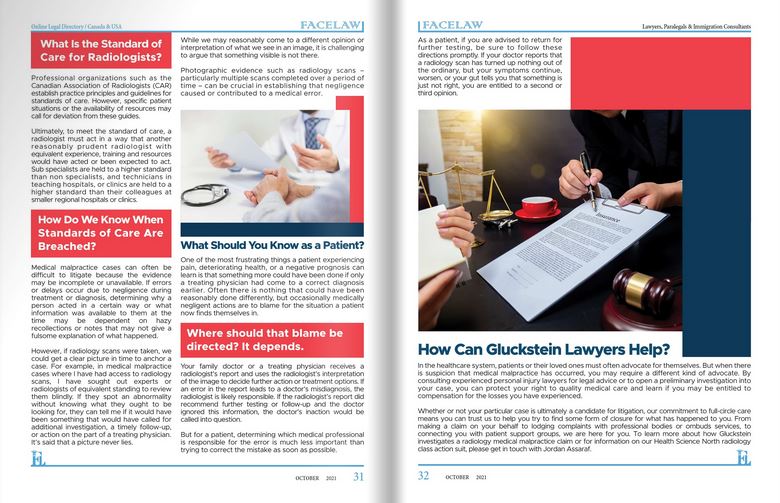Radiology Misinterpretation and Misdiagnosis
Radiology Misinterpretation and Misdiagnosis
By Janet Lebeau, Senior Law Clerk
A photograph captures a moment in time. In our day to day lives, we most often take photos of happy occasions or of scenes and objects that fascinate or inspire us.
Photos and imaging are also used to preserve memories of less positive aspects of life: photojournalism may record natural disasters and conflicts, police often rely on crime scene photos, and medical imaging can provide evidence of abnormalities and malignant tumours that may not turn up through other diagnostic tests.
Advances in radiology scanning technology have been hugely beneficial to doctors and their patients in recent years. Being alerted to a potential problem on a scan early enough can make a significant difference to patient outcomes. But if these images are misinterpreted by technicians and, as a result, the patient is misdiagnosed by their doctor, it can lead to unnecessary pain, disability, shortened life-expectancy or even death.
In this blog post, I explain how medical negligence can cause or contribute to misinterpretation and/or misdiagnosis of radiology imaging and what you can do if you believe you or a loved one has been a victim of medical malpractice.
Where Is the Line Between Human Error and Negligence?
Since x-ray technology was first discovered and used for diagnostic purposes at the end of 19th century, radiology imaging has grown increasingly advanced. Magnetic resonance imaging and ultrasound imaging have expanded what medical professionals are able to see in soft tissue structures, internal organs and particularly sensitive parts of the body such as the brain.
As these scans are refined, radiologists must continually update and refresh their technical skills to ensure they can use these detailed pictures to the full extent possible. However, human error is still possible.
Research indicates that between three to five percent of interpretations by radiologists in their daily practice contain errors. Most of these errors are minor and do not substantially affect patient outcomes – particularly if they are discovered through prompt follow-ups. However, studies which looked at the “retrospective miss rate” (where patient scans are reviewed at a later date) found as many as 30 percent of these scans contained significant pathologic findings that were not identified. In retrospective cases of patients who developed lung or breast carcinomas (cancers), reviews of scans found evidence of these pathologies in 90 and 75 percent of cases, respectively.
Unfortunately, while these errors may delay potential treatment and adversely affect patient outcomes, a mistake by itself is not enough to establish a legal case that could result in compensation for the victim. To establish medical malpractice, the error that caused or contributed to a patient’s losses must have occurred due to a breach in the standard of care.
What Is the Standard of Care for Radiologists?
Professional organizations such as the Canadian Association of Radiologists (CAR) establish practice principles and guidelines for standards of care. However, specific patient situations or the availability of resources may call for deviation from these guides.
Ultimately, to meet the standard of care, a radiologist must act in a way that another reasonably prudent radiologist with equivalent experience, training and resources would have acted or been expected to act. Sub-specialists are held to a higher standard than non-specialists, and technicians in teaching hospitals, or clinics are held to a higher standard than their colleagues at smaller regional hospitals or clinics.
How Do We Know When Standards of Care Are Breached?
Medical malpractice cases can often be difficult to litigate because the evidence may be incomplete or unavailable. If errors or delays occur due to negligence during treatment or diagnosis, determining why a person acted in a certain way or what information was available to them at the time may be dependent on hazy recollections or notes that may not give a fulsome explanation of what happened.
However, if radiology scans were taken, we could get a clear picture in time to anchor a case. For example, in medical malpractice cases where I have had access to radiology scans, I have sought out experts or radiologists of equivalent standing to review them blindly. If they spot an abnormality without knowing what they ought to be looking for, they can tell me if it would have been something that would have called for additional investigation, a timely follow-up, or action on the part of a treating physician.
It’s said that a picture never lies. While we may reasonably come to a different opinion or interpretation of what we see in an image, it is challenging to argue that something visible is not there.
Photographic evidence such as radiology scans – particularly multiple scans completed over a period of time – can be crucial in establishing that negligence caused or contributed to a medical error.
What Should You Know as a Patient?
One of the most frustrating things a patient experiencing pain, deteriorating health, or a negative prognosis can learn is that something more could have been done if only a treating physician had come to a correct diagnosis earlier. Often there is nothing that could have been reasonably done differently, but occasionally medically negligent actions are to blame for the situation a patient now finds themselves in.
Where should that blame be directed? It depends.
Your family doctor or a treating physician receives a radiologist’s report and uses the radiologist’s interpretation of the image to decide further action or treatment options. If an error in the report leads to a doctor’s misdiagnosis, the radiologist is likely responsible. If the radiologist’s report did recommend further testing or follow-up and the doctor ignored this information, the doctor’s inaction would be called into question.
But for a patient, determining which medical professional is responsible for the error is much less important than trying to correct the mistake as soon as possible.
As a patient, if you are advised to return for further testing, be sure to follow these directions promptly. If your doctor reports that a radiology scan has turned up nothing out of the ordinary, but your symptoms continue, worsen, or your gut tells you that something is just not right, you are entitled to a second or third opinion.
How Can Gluckstein Lawyers Help?
In the healthcare system, patients or their loved ones must often advocate for themselves. But when there is suspicion that medical malpractice has occurred, you may require a different kind of advocate. By consulting experienced personal injury lawyers for legal advice or to open a preliminary investigation into your case, you can protect your right to quality medical care and learn if you may be entitled to compensation for the losses you have experienced.
Whether or not your particular case is ultimately a candidate for litigation, our commitment to full-circle care means you can trust us to help you try to find some form of closure for what has happened to you. From making a claim on your behalf to lodging complaints with professional bodies or ombuds services, to connecting you with patient support groups, we are here for you.
To learn more about how Gluckstein investigates a radiology medical malpractice claim or for information on our Health Science North radiology class action suit, please get in touch with Jordan Assaraf.




Click here for go to Charles E. Gluckstein Page
top lawyer in toronto
list of lawyers in toronto
lawyers in canada
top lawyer in canada
list of lawyers in canada
lawyer in canada
Slip and Falls lawyer in GTA
bicycle accident lawyer in GTA
car accident lawyer in Toronto
accident lawyer in Toronto
spinal cord injury lawyer in canada
Medical malpractice lawyers in toronto
long term disability lawyer in Canada
injury lawyer in Canada
wrongful death lawyer in Canada
personal injury lawyers in Canada
slip and fall lawyer in Canada
birth injury lawyer in Canada
brain injury lawyer in Canada
list of experience lawyers in toronto
lawyer in toronto
Criminal Harassment lawyer in canada
top iranian criminal lawyer in canada
Long term disability lawyer in Toronto
Criminal Harassment lawyer in toronto
Assault with a Weapon lawyer in toronto
sexual assault lawyer in toronto
sexual assault lawyer in canada
Assault with a Weapon lawyer in canada


